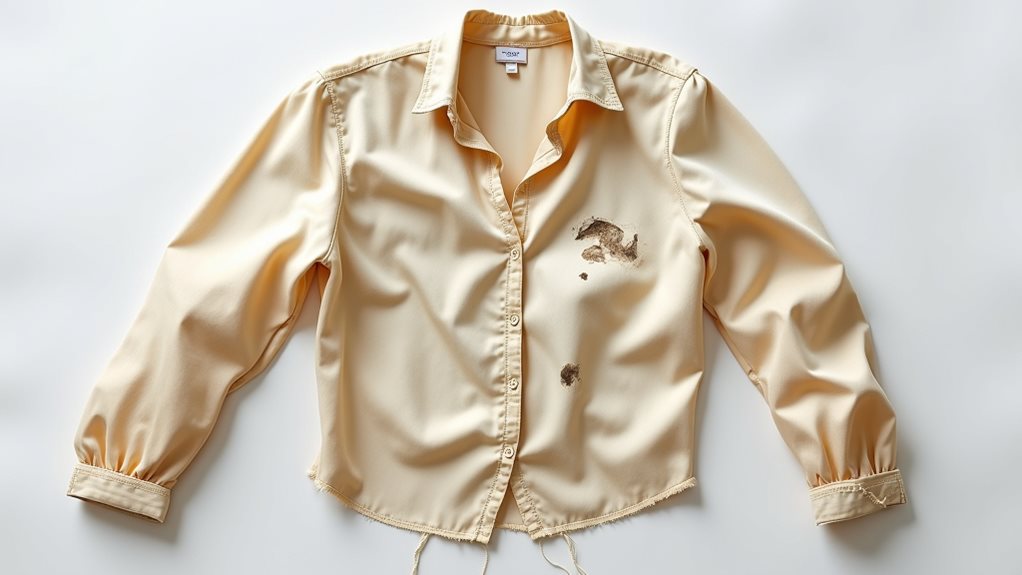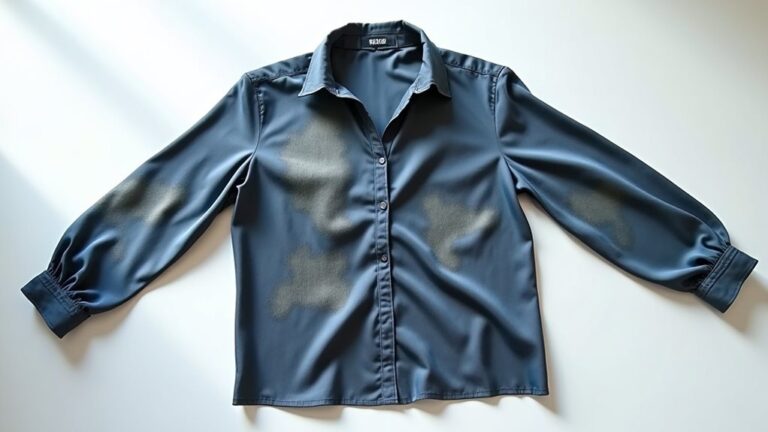When you wash a dry clean only garment, you’re fundamentally rolling the dice with your favorite pieces, and trust me, the house usually wins. Delicate fabrics like silk will shrink, lose their lustrous sheen, and bleed colors into uneven, blotchy patches that’ll make you cringe. Wool transforms through felting into a matted mess, while leather cracks and loses flexibility permanently. The machine’s agitation tightens fibers, causing irreversible shape loss that’ll leave your once-beautiful garment looking like it belongs in the donation pile. Understanding these specific reactions can help you make smarter decisions about your wardrobe’s future.
Understanding Dry Clean Only Labels and What They Really Mean
When you spot that dreaded “dry clean only” label sewn into your favorite blazer or delicate blouse, it’s more than a suggestion from manufacturers trying to make your life more complicated—it’s actually a crucial warning that could save you from turning your beloved garment into an expensive disaster.
These care labels exist because certain delicate fabrics like silk, wool, and velvet simply can’t handle the rough-and-tumble world of your washing machine’s spin cycle.
The manufacturers aren’t being dramatic when they recommend professional cleaning—they’re protecting you from irreversible damage that transforms a perfectly good piece into expensive cleaning rags.
Understanding what these dry clean only items truly need helps you preserve your wardrobe investments and avoid those heartbreaking “oops” moments we’ve all experienced.
Dry cleaning uses chemical solvents instead of water to remove stains and dirt while preserving the fabric’s integrity, shape, and texture that water-based washing would compromise.
Common Fabric Damage That Occurs When Machine Washing Delicate Garments
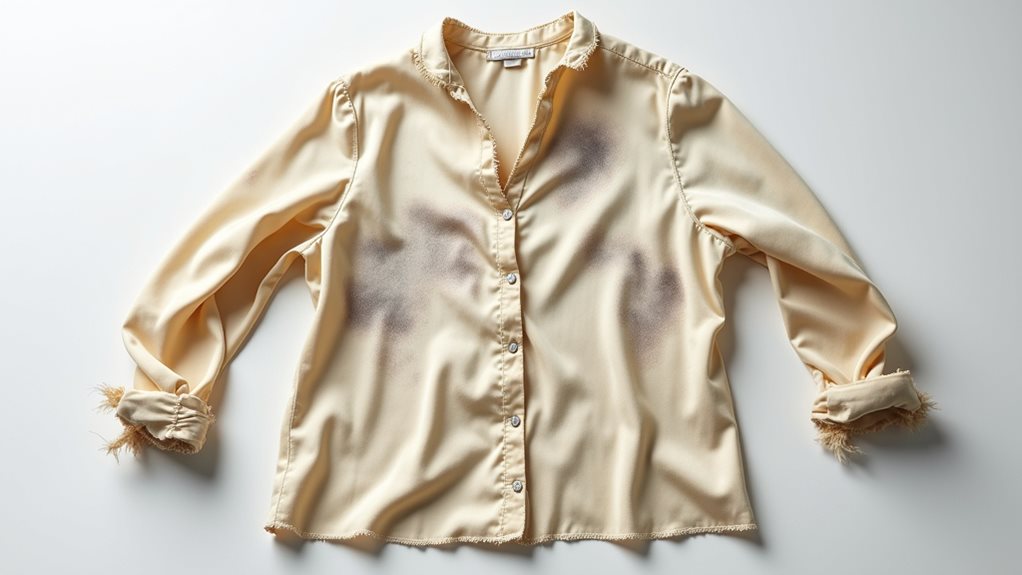
When you toss that gorgeous silk blouse or wool sweater into your washing machine, you’re fundamentally rolling the dice with your wardrobe, and trust me, the house usually wins.
The most heartbreaking damage you’ll likely encounter is shrinkage and shape loss, where your favorite cashmere cardigan transforms from a perfect fit into something that might work for your younger sibling 😅.
Color bleeding presents another cruel twist of fate, as those rich, vibrant dyes decide to take a little vacation from their original fabric home, leaving you with faded garments or, worse yet, a load of laundry that’s all mysteriously turned the same unfortunate shade.
While dry cleaning preserves your delicate fabrics, many facilities are now switching to safer alternatives like wet cleaning and hydrocarbon solvents instead of traditional chemical processes.
Shrinkage and Shape Loss
Although I learned this lesson the hard way with my favorite cashmere sweater, shrinkage remains one of the most heartbreaking consequences you’ll face when machine washing dry clean only garments.
You’ll watch helplessly as your perfectly fitted blazer transforms into something that might fit your teenage nephew, and delicate fabrics like wool contract dramatically when exposed to water and agitation.
The washing machine’s heat and movement cause fibers to tighten and compress, creating permanent shape loss that no amount of stretching can reverse.
Even worse, you’re risking color bleeding that’ll ruin other clothes in the same load.
While dry cleaning uses chemical solvents instead of water to reduce shrinkage risk, it’s specifically designed for these delicate materials that can’t withstand traditional washing methods.
Trust me, the convenience of home washing simply isn’t worth destroying your investment pieces – I’ve got the shrunken sweater to prove it!
Color Bleeding Issues
Why is it that the most beautiful, vibrant garments seem to be the ones that betray us most dramatically in the washing machine?
When you subject delicate fabrics to machine washing, you’re fundamentally playing Russian roulette with your wardrobe, and color bleeding becomes your biggest nightmare.
Those gorgeous deep dyes that initially attracted you become unstable when exposed to water and agitation, transforming your favorite silk blouse into a faded shadow of its former self.
Here’s what you need to watch for:
- Bright or dark-colored garments releasing dye into wash water
- Embellished items with sequins or beads losing color integrity
- Adjacent clothing becoming permanently stained
- Irreversible damage to fabric vibrancy
- Complete color transfer between garments
Professional dry cleaning uses chemical solvents instead of water, which prevents the dye instability and color bleeding that occurs with traditional washing methods.
Always conduct a spot test on hidden seams before considering hand washing over dry cleaning.
How Different Materials React to Water and Agitation
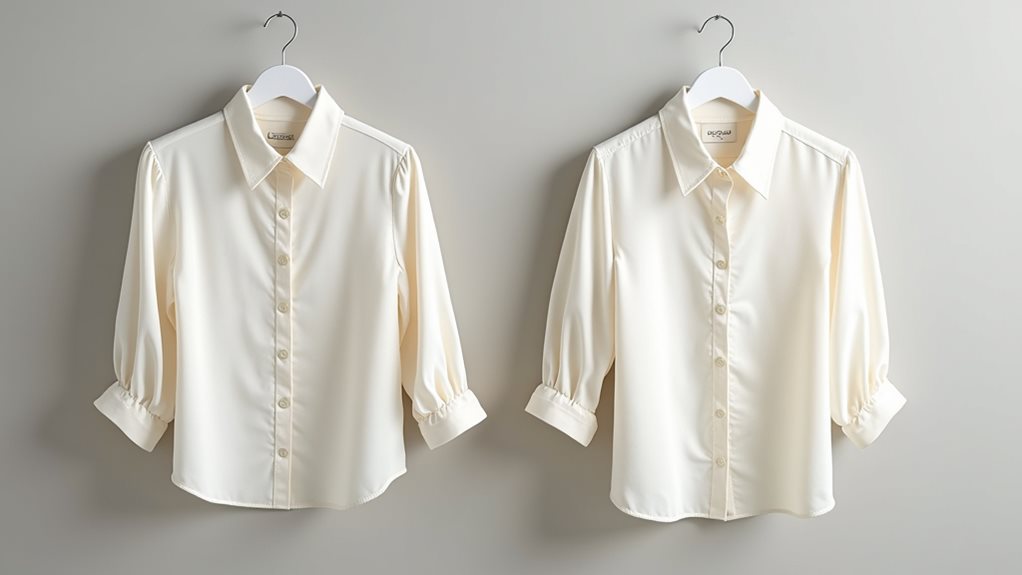
When you toss that gorgeous silk blouse into your washing machine, you’re fundamentally watching expensive fabric commit slow suicide, as the water strips away vibrant colors faster than you’d lose money at a casino 🎰.
Your favorite wool sweater will shrink into what looks like doll clothes while simultaneously turning into a felted mess that resembles something you’d find at a craft store gone wrong.
Meanwhile, any leather accents or trim will crack and split like dried mud, leaving you with a garment that’s worth less than the detergent you used to destroy it.
After ruining your expensive garments, you’ll also need to figure out what to do with those dry cleaning hangers that accumulate over time, since most can’t be recycled through regular programs.
Silk Loses Color Fast
Since silk behaves like that friend who can’t handle even the slightest bit of drama, it reacts to water and washing machine agitation by immediately losing its gorgeous, vibrant colors in ways that’ll make you want to cry.
When you ignore those care instructions on your dry clean only garment, you’re basically asking for heartbreak.
Here’s what happens when you’re washing delicate silk items:
- The dye bleeds faster than gossip spreads at a family reunion
- Machine agitation weakens fibers, causing structural damage and more color bleeding
- Heat and moisture dull silk’s natural sheen, making it look lifeless
- Untreated silk is especially vulnerable to losing colorfastness
- Even cold water can’t fully protect delicate items from damage
Trust me, dry cleaners exist for a reason – they’ll keep your silk looking fabulous! 💫
While traditional dry cleaning uses chemical solvents like perchloroethylene that can leave residues on garments, it’s still much safer for delicate fabrics than risking water damage.
Wool Shrinks and Felts
If you’ve ever accidentally tossed a wool sweater into the washing machine, you probably know that sinking feeling I’m talking about – the one where you open the lid and find what looks like doll clothes where your favorite cardigan used to be.
Wool and cashmere are particularly vulnerable to water and agitation, which triggers a one-way transformation that’ll make you want to cry. The shrinkage happens because those delicate fibers literally interlock and mat together in a process called felting, creating a dense, compact mess that no amount of stretching can fix.
Your best bet is always hand washing in cold water without any aggressive handling, because these luxurious materials have very specific care needs. This is why dry cleaning services use chemical solvents instead of water and heat to preserve the shape and size of these delicate garments.
Leather Cracks When Wet
While wool might leave you with tiny sweaters, leather takes water damage to a whole different level of heartbreak – and trust me, I learned this the hard way after a particularly rainy concert left my favorite leather jacket looking like it had aged about twenty years overnight.
When you ignore those dry clean only clothes tags on leather items, you’re basically signing up for disaster.
Here’s what happens when leather cracks when wet:
- Water exposure strips away natural oils, leaving the material brittle and prone to cracking
- Agitation causes leather to lose shape and flexibility permanently
- Color changes create uneven, blotchy patches across the surface
- Texture becomes rough and damaged beyond repair
- Once cracked, the damage can’t be reversed
Unlike fabrics like wool that might bounce back with proper care, leather requires specialized cleaners to clean delicate materials properly. Professional dry cleaners use safer alternatives like liquid CO2 or wet cleaning methods that won’t damage your leather items the way traditional home washing would.
The Risk of Shrinkage, Color Bleeding, and Structural Changes
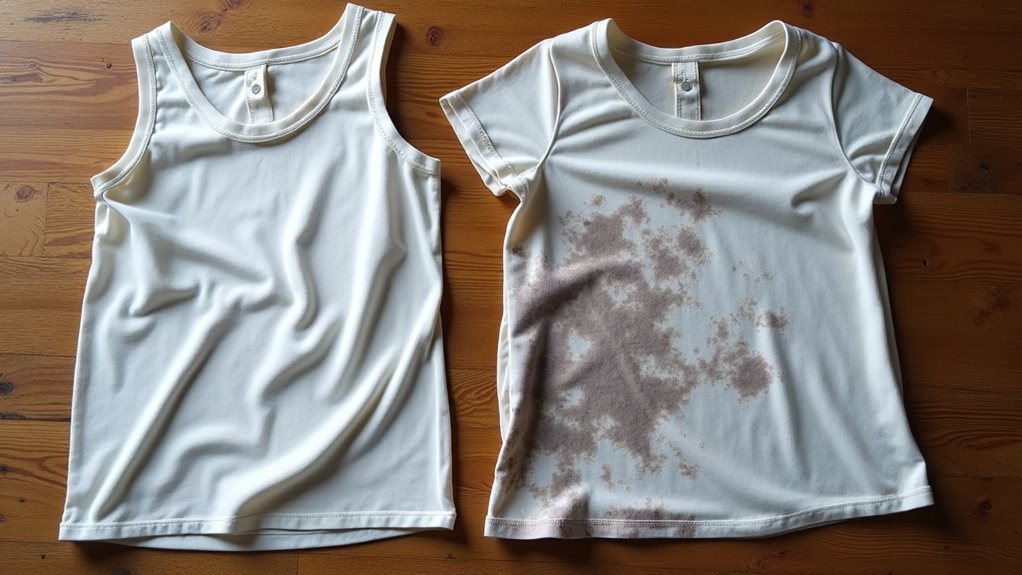
When you toss that “dry clean only” blazer into your washing machine, thinking you can outsmart the care label, you’re fundamentally rolling the dice with your wardrobe’s future.
I’ve watched friends turn their favorite wool sweaters into doll clothes through shrinkage, and trust me, it’s heartbreaking.
Color bleeding becomes your worst enemy when that burgundy silk blouse turns your white shirt pink forever.
Delicate fabrics like rayon are particularly unforgiving, often puckering beyond repair when they meet water and agitation.
Structural changes occur rapidly—seams loosen, linings shift, and embellishments fall victim to the washing cycle’s harsh reality.
Professional dry cleaners use chemical solvents instead of water, which is precisely why they can safely clean these delicate garments without causing the devastating damage that home washing inflicts.
Those care tags aren’t suggestions; they’re lifelines preventing you from joining the unfortunate statistic of people who’ve ruined clothing through washing mistakes.
When You Might Be Able to Hand Wash Instead of Dry Clean
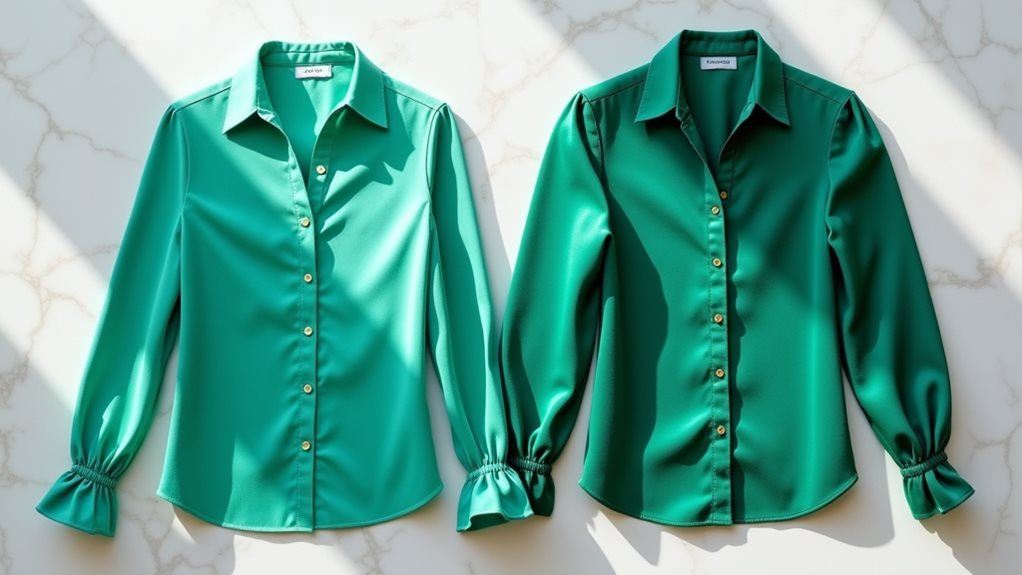
Although those care labels seem written in stone, there’s actually some wiggle room for certain garments that won’t completely fall apart if you treat them with the gentleness they deserve.
Care labels aren’t absolute law—with the right gentle approach, some “forbidden” garments can actually survive a careful home wash.
I’ve successfully rescued a few “dry clean only” pieces by following these careful steps:
- Start with a spot test on a hidden seam to check for color bleeding or fabric damage
- Choose sturdy fabrics like cotton or linen over delicate fabrics such as silk or wool
- Use cool water and mild detergent to minimize shrinkage and color loss
- Avoid embellished pieces with beading, sequins, or complex linings that could separate
- Skip wringing or twisting – gently squeeze out excess water instead
Keep in mind that specialized solvents used in professional dry cleaning cannot be replicated at home, which is why these methods carry inherent risks.
When in doubt, professional cleaning remains your safest bet, especially for treasured pieces you can’t afford to lose.
Alternative Cleaning Methods to Preserve Your Delicate Clothing
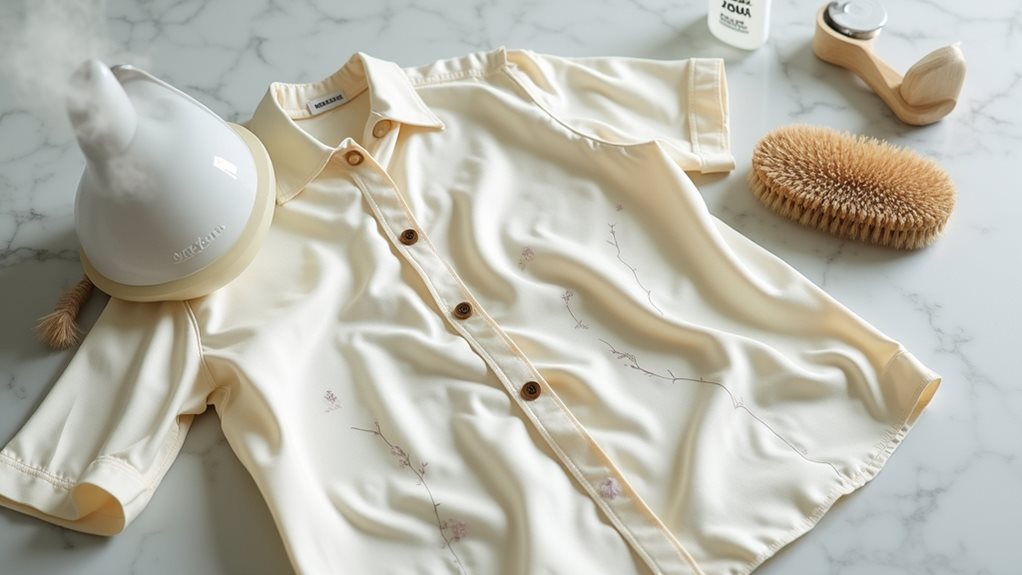
Beyond hand washing, there’s a whole toolkit of gentler approaches that can keep your delicate pieces looking fresh without the expense or chemicals of professional cleaning.
I’ve learned that spot cleaning with mild detergent works wonders for minor stains—no need to subject your entire silk blouse to a full wash when you’ve just spilled coffee on the sleeve.
Fabric-specific sprays can breathe new life into delicate items, reducing wrinkles and adding freshness without water damage.
When you do hand wash, cool water is your friend, but resist the urge to wring or twist (trust me, I’ve ruined too many sweaters this way 😅).
Always lay garments flat to dry, and consider protective mesh bags for machine-washable care labels.

